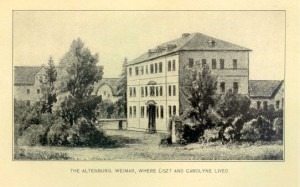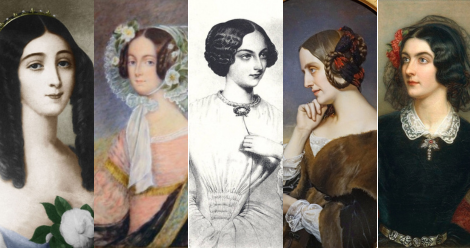
Carolyne von Sayn-Wittgenstein
The differences between Marie Duplessis and Carolyne von Sayn-Wittgenstein could not have been more pronounced. Marie experienced a wretched and squalid upbringing with Daddy selling her into prostitution by age 12. Carolyne Ivanovska, on the other hand, was the only daughter of a rich Polish nobleman. When she was seventeen, her father bought her a husband, the son of Field Marshal Wittgenstein, who had huge estates in the Ukraine. Marie eventually resided in some of the most lavish and posh apartments in Paris, while Carolyne lived in an enormous castle, surrounded by one hundred servants and ruling over thirty thousand serfs. Marie was beautiful beyond words, while Carolyne was described as “short and dumpy, with small, dark, saturnine features.” When people told Liszt that she was ugly, he replied “I, who can claim to be a connoisseur in such matters, maintain that she is beautiful, because her soul lends her face the transfiguration of the highest beauty.” But what really set these two women apart was the fact that Carolyne, just like Franz, was a certified religious nutcase.
Pater Noster, S41/1/R521a
In February 1847, Franz Liszt gave a charity concert in Kiev with Carolyne in the audience. The very next day, she heard Liszt’s “Pater Noster” sung in church and quickly offered him lots of money to build a diorama of scenic effects to express his impressions of Dante’s “Divina Commedia.” The diorama was never built, but once Franz made it into her bedroom, he was hooked for life. According to some reports, her alcove was made entirely of roughly-shaped grey stones, resembling a monk’s cell, with hundreds of crucifixes adorning the walls. Countless bibles and ashtrays surrounded her bed, as Carolyn continuously smoked exceedingly strong cigars. Richard Wagener called her “a monstrum in excessum of brain and heart,” and Marie d’Agoult delightedly wrote to Franz, “ for the greatest joy of my heart would be to see you straightened out.” We are not sure whether whips, chains and hourly flagellations were part of the bedroom routine, but the relationship, in one form or another, lasted for almost 40 years. In 1848, Liszt was appointed music director in Weimar, and the happy couple moved into the Villa Altenberg. For the next 12 years, the Altenberg became the holy shrine celebrating the personal cult surrounding Franz Liszt.
Richard Wagner made the pilgrimage and was much impressed, so much so that he would divorce his wife Minna and married Liszt’s daughter Cosima, who in turn would divorce the conductor Hans von Bülow. Johannes Brahms came for a visit and when Liszt played through his newly composed B-minor Sonata, promptly fell asleep.
Piano Sonata in B minor, S178/R21

Villa Altenberg
Liszt increasingly withdrew from public performances — although he was still highly active as a conductor — and focused on composition and his literary writings. During the Altenberg years, Franz composed most of his twelve Symphonic Poems and the “Faust” and “Dante” Symphonies. Carolyne and Franz worked closely together in an almost churchlike atmosphere of religious solitude, and it has been suggested that Carolyne was the actual author of several of Liszt’s literary publications, particularly his “Life of Chopin.” However, one major irritant remained. Carolyne was still married, and needed the Pope’s permission to get her union to Prince Wittgenstein annulled. After a lengthy and rather intricate process of negotiations, the annulment was temporarily granted and the couple planned to marry in Rome on Liszt’s 50th birthday, October 22, 1861. Franz even composed his “Festklänge” for the happy occasion.
However, Prince Wittgenstein lodged a protest with the Russian Orthodox Church, the annulment was withdrawn and the Tsar impounded their Ukrainian properties. Franz, who could not cope with rejection of any kind, became increasingly addicted to alcohol. In addition, he was prone to bouts of depression and lack of creative energy. He wrote, “I am mortally sad; I can say nothing and listen to nothing. Only prayer can console me and that only now and then.” When Prince Wittgenstein obtained his divorce a couple of years later, talk of marriage was once again in the air. However, Carolyne procrastinated over the property settlement, and the wedding was repeatedly postponed. In the end, Franz got tired of waiting and by papal dispensation was admitted into Holy Orders on 25 April 1865. Carolyne was now confronted with a tonsured Abbe, and the relationship quickly turned into a platonic friendship. They continued to correspond feverishly, and when Franz died on 31 July 1886, his will declared the princess to be his sole heir. Carolyn outlived Franz by only a couple of months. She was buried in Rome, and they played the “Requiem” Liszt had written for the death of the Emperor Maximilan at her funeral.


février 1847 – concert de Liszt à Kiev
75 years ago, in Ukrainia
A moment to remember, not only because of Carolyne
Liszt’s “Requiem” for all those dead
Liszt’s Sonata for peace